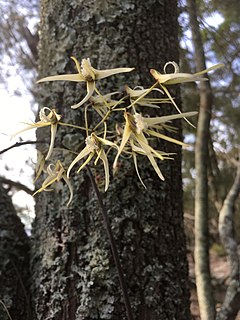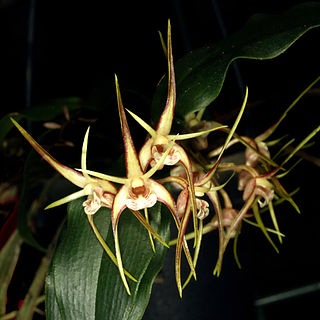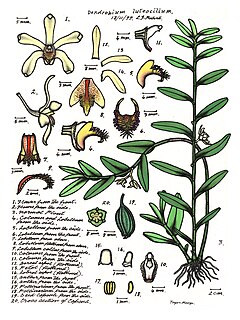
Dendrobium cunninghamii, commonly known as winika, pekapeka, Christmas orchid, bamboo orchid or ladies slipper orchid, is a species of epiphytic orchids that is endemic to New Zealand. It is commonly found growing in rainforest in the North, South, Stewart and Chatham Islands and normally flowers in summer and early autumn.

Dendrobium teretifolium, commonly known as the thin pencil orchid, rat's tail orchid or bridal veil orchid, is an epiphytic or lithophytic orchid in the family Orchidaceae. It has long, thin hanging stems, pencil-like leaves and rigid flowering stems bearing up to twelve crowded white to cream-coloured flowers. It grows in rainforest and humid open forest mostly in near-coastal districts in New South Wales and Queensland.

Dendrobium discolor, commonly known as antler orchid, is a species of epiphytic or lithophytic orchids in the family Orchidaceae, and are native to northern Australia, New Guinea, and part of Indonesia. It has cylindrical pseudobulbs, each with between ten and thirty five leathery leaves, and flowering stems with up to forty mostly brownish or greenish flowers with wavy and twisted sepals and petals.

Dendrobium gracilicaule, commonly known as the blotched cane orchid or yellow cane orchid, is an epiphytic or lithophytic orchid in the family Orchidaceae. It has cylindrical pseudobulbs, between three and seven thin leaves and up to thirty often drooping, cream-coloured to yellow or greenish flowers, sometimes with reddish brown blotches on the back. There are two varieties, one occurring in Queensland and New South Wales and the other on some Pacific Islands, including Lord Howe Island.

Dendrobium tetragonum, commonly known as the tree spider orchid, is a variable species of epiphytic or lithophytic orchid endemic to eastern Australia. Tree spider orchids are unusual in having pendulous pseudobulbs that are thin and wiry near the base then expand into a fleshy, four-sided upper section before tapering at the tip. There are only a few thin but leathery leaves at the end of the pseudobulbs and up to five flowers on relatively short flowering stems. To allow for the variations in the species there are five subspecies and a variety, some with a unique common name.

Dendrobium moorei, commonly known as the drooping cane orchid, is a species of epiphytic or lithophytic orchid in the family Orchidaceae and is endemic to Lord Howe Island. It has cylindrical pseudobulbs, leathery, dark green leaves and between two and fifteen small, white drooping flowers that do not open widely.
Dendrobium macropus, commonly known as the Norfolk Island cane orchid, is a species of epiphytic or lithophytic orchid in the family Orchidaceae and is endemic to Norfolk Island. It has cylindrical pseudobulbs, thin, dark green leaves and between five and ten yellowish green flowers that do not open widely.
Dendrobium brevicaudum, commonly known as the Mount Finnigan pencil orchid, is an epiphytic or lithophytic orchid in the family Orchidaceae and is endemic to Queensland. It has hanging stems, cylindrical leaves and groups of about six yellowish or orange-brown flowers with red streaks and a white labellum. It is only known from two mountainous areas north of Cairns.

Dendrobium cucumerinum, commonly known as the cucumber orchid or gherkin orchid, is a species of orchid endemic to eastern Australia. It is an epiphytic orchid with creeping stems, gherkin-like leaves and flowering stems with up to eighteen cream-coloured, yellowish or greenish white flowers with purple stripes. It often grows on large trees near streams but is also found in drier forests.

Sarcochilus parviflorus, commonly known as the southern lawyer orchid or green tree orchid, is an epiphytic orchid endemic to eastern Australia. It has up to eight rigid leaves and up to twelve small bright green to yellowish green flowers with reddish markings on the labellum.

Dendrobium adae, commonly known as the slender cane orchid, is an epiphytic, sometimes lithophytic orchid in the family Orchidaceae. It has cylindrical pseudobulbs, up to four dark green leaves and up to six white or greenish to apricot-coloured flowers. It grows in tropical North Queensland, Australia.

Dendrobium agrostophyllum, the buttercup orchid, is an epiphytic or lithophytic orchid in the family Orchidaceae and has a creeping rhizome with well-spaced pseudobulbs. Each pseudobulb has up to twenty grass-like leaves, some of the leaves having flowering stems on the opposite side of the pseudobulb, each raceme with up to ten waxy, fragrant, bright yellow flowers. It grows in wet forest in coast areas of north Queensland, Australia.
Dendrobium fellowsii, commonly known as the native damsel orchid, is an epiphytic or lithophytic orchid in the family Orchidaceae and has upright pseudobulbs, up to five leaves and groups of up to five pale green or yellowish flowers with a deep purple labellum. It grows in tropical North Queensland.

Dendrobium schoeninum, commonly known as the common pencil orchid, is an epiphytic or sometimes a lithophytic orchid in the family Orchidaceae and has thin wiry, upright or pendent stems with fleshy, grooved, dark green leaves. Its short flowering stems have one or two, rarely up to four pale green, cream-coloured or mauve flowers with purple markings on the labellum. It grows on rainforest margins in coastal New South Wales and southern Queensland.

Dendrobium bifalce, commonly known as the native bee orchid, is an epiphytic or lithophytic orchid in the family Orchidaceae. It has spindle-shaped pseudobulbs with up to four leathery leaves and up to ten pale green or greenish yellow flowers with purplish markings. It grows on trees and boulders in rainforest in tropical North Queensland, Australia and in New Guinea.

Dendrobium bowmanii, commonly known as the straggly pencil orchid, is an epiphytic or lithophytic orchid in the family Orchidaceae. It has thin wiry, straggly stems with a small number of small leaves and up to four greenish or brownish flowers with a conspicuous white labellum. It grows in drier rainforests and coastal scrub in New South Wales, southern Queensland and New Caledonia.

Dendrobium fleckeri, commonly known as the apricot cane orchid, is a species of epiphytic or lithophytic orchid endemic to far north Queensland, Australia. It has cylindrical pseudobulbs with two or three dark green leaves and up to four apricot-coloured or yellowish green flowers with tangled white hairs on the edge of the labellum.

Dendrobium pruinosum, commonly known as the honey orchid, is an epiphytic or lithophytic orchid in the family Orchidaceae and has flattened, yellowish stems and pairs of cream coloured, dull yellow or greenish flowers. It grows in tropical North Queensland and New Guinea.

Dendrobium tozerense, commonly known as the white gemini orchid, is an epiphytic or lithophytic orchid in the family Orchidaceae. It has thin, wiry stems, stiff leaves and pairs of star-shaped, white flowers. It grows in rainforest in tropical North Queensland, Australia.

Dendrobium malbrownii, commonly known as the McIlwraith hermit orchid, is an epiphytic or lithophytic orchid in the family Orchidaceae and is endemic to tropical North Queensland, Australia. It has thin, wiry, crowded stems each with narrow, dark green leaves and a single shiny, cream-coloured flower with a purple labellum. It grows on trees, fallen logs and rocks in rainforest on the McIlwraith Range.

















